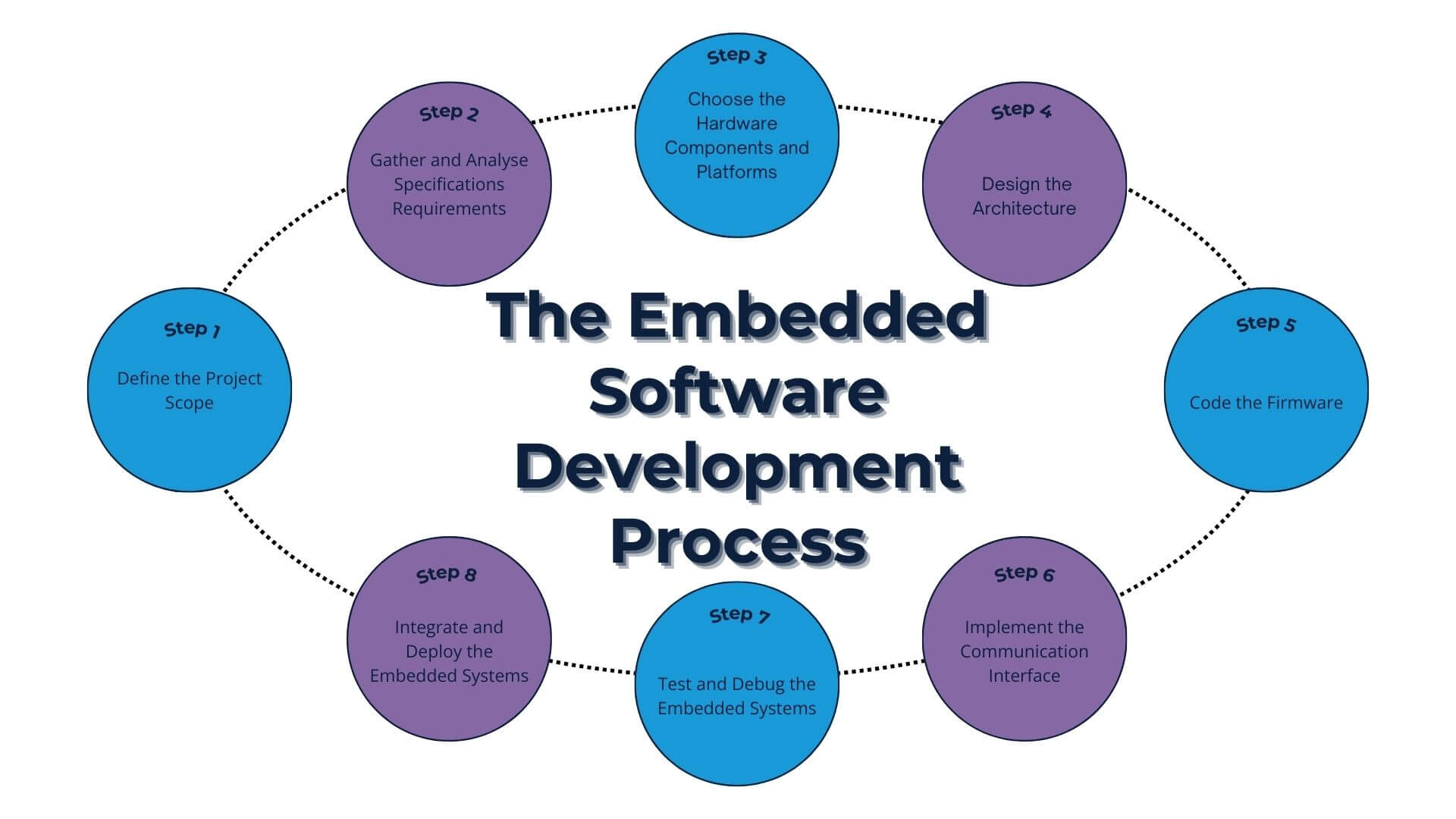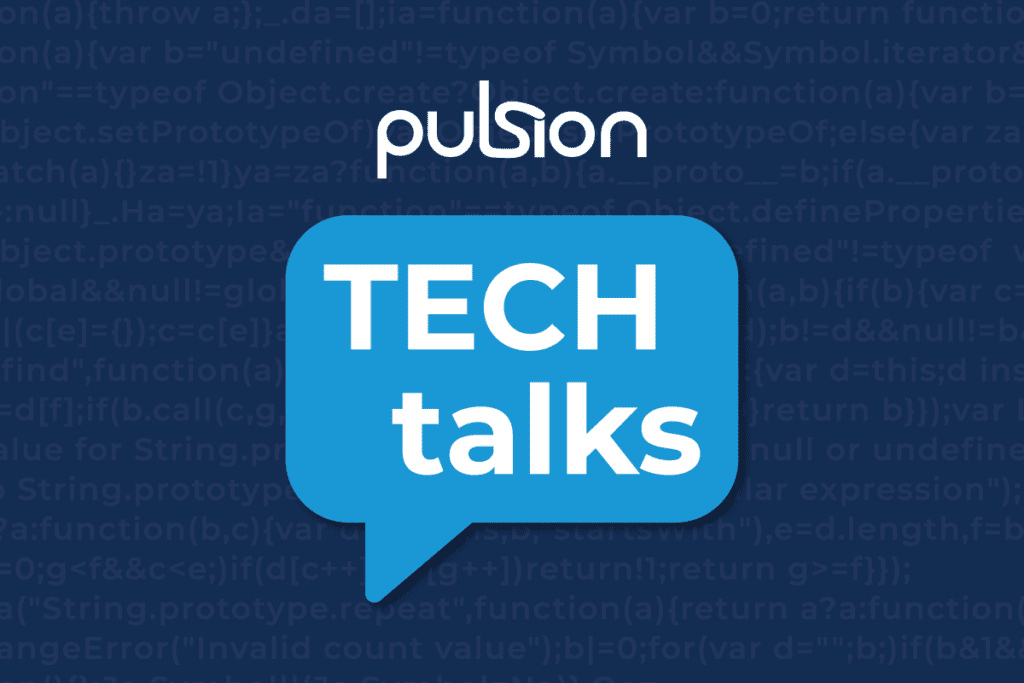Embedded software development services include software development for embedded systems, firmware development, integration, and embedded programming.
Embedded software research shows that 30 microprocessors per person existed in 2008 in developed countries, increasing by 10-20% each year.
Meanwhile, the most common industries using embedded software development services include technology, manufacturing, Fortune 500 companies, professionals, and automotive.
Let’s read into why referred embedded software services and development are in high demand by understanding what type of development embedded software is and how it works.
What Is Embedded Software Development?
Embedded software is developed by embedded software engineers as a built-in system in embedded devices other than regular computers. Embedded software is a form of computer software used to control machines and non-computer devices.
Embedded software development creates software specifically designed to operate within embedded systems in non-computer devices. The software allows hardware and software on devices to interact.
However, the device brain or software embedded in hardware chips is constrained by limited memory space and data processing, low-cost microcontrollers, and stringent regulations.
Let’s dive deeper into embedded system engineering.
An Overview of Embedded Software Development Services
The embedded software industry includes embedded software developers. Some services to expect from embedded software companies include:
- The development of embedded software systems
- Firmware development and integration
- Writing embedded systems programming languages
- Porting or migration
- Thorough software evaluation and updates
- Maintenance and support for embedded software
Our Other Software Development Services
In addition to our specialised offerings in embedded systems, our comprehensive suite of services extends to cater to a diverse array of software development needs. Whether you’re looking to harness the power of AI and machine learning for advanced analytics and automation, or need expert assistance in migrating your data and applications to the cloud, we have the expertise to support your goals. Our custom software development is tailored to fit your unique requirements, providing bespoke solutions that drive value. We also specialise in crafting responsive and robust web applications, offering custom web app development services that integrate seamlessly with your business operations. For businesses targeting mobile-first audiences, our mobile app development services deliver sleek, functional, and intuitive applications for all major platforms. Additionally, our WordPress development services ensure that managing content and maintaining a dynamic online presence is simpler and more effective than ever. Find out more here:
Mobile App Development Services
WordPress Development Services
Important Features of Embedded Software
Embedded systems are specifically designed to perform and complete specified tasks with a compact hardware design. Embedded software developers optimise the software to integrate with limited space.
Embedded systems must ultimately have low energy consumption, high performance, and real-time capabilities in various devices.
Importance of Embedded Software Development
The benefits of embedded software include:
- Can be tailored to specific design requirements
- Custom hardware components and development
- Fewer interconnections for embedded systems
- Low-power consumption reduces energy costs
- Mass production capabilities for larger industries
- Maximises microprocessors and memory abilities
- Minimal hardware requirements for cost-effective software solutions
- Provides performance stability and consistency
- Provides a real-time response to reduce repeat errors
Typical Embedded Software Challenges
Embedded software is often found in medical devices, equipment, or automotive industries. For that reason, depending on the type, some challenges with developing an embedded system include:
- Ensuring compatibility and integrity between multiple hardware and firmware is a complex task
- Embedded software isn’t user-friendly and is only capable of limited data storage
- Embedded systems must be capable of detecting critical faults in real-time operating systems (RTOS)
- Following safety standards in lifesaving technology and critical environments is a must
- System stability issues or unexpected behaviour arise without standardised development
- Embedded device software requires high-level security measures to prevent data hijacking
- Packing more computing power into smaller hardware devices is tricky and causes a limited design
- Memory constraints in the read-only memory (ROM) and random access memory (RAM) add to the complexity of development
What Are the Key Components of Embedded Systems?
Embedded systems operate when software and hardware interact with each other. For example, embedded Linux is a tailored operating system version of Linux OS.
However, embedded systems have key components in two layers: hardware and software. Let’s understand the key differences between hardware and software layers.
Hardware Layer in Embedded Systems
The hardware layer in embedded systems in a particular device comprises the following components:
- CPU – A central processing unit to receive data from the software and process set responses.
- Power Supply – Hardware to help the system on chip charge via battery or electrical plug.
- RAM or ROM Memory – The random access memory and read-only memory capabilities hardware.
- Timers – Hardware to guide a smart home system to switch the lights off at a specified time.
- User Interface – A set of buttons, features, and actions available to device users.
Also, the hardware surface has communication ports used to communicate with other computers or systems, including:
- A universal serial bus (USB) drive
- Controller area network (CAN)
- Firewire
- Inter-integrated circuit (I2C)
- SAE J1587/J1708
- Serial peripherals interface (SPI)
- Universal asynchronous receiver/transmitter (UART)
Software Layer in Embedded Systems
The software layer in embedded systems in various devices comprises the following:
- Application Software – Applications that run exclusively in real-time operating systems.
- Device Drivers – Facilitates specific hardware-software communication and seamless functions.
- Firmware – Controls booting processes, hardware interface maintenance, and low-level operations.
- Machine Learning Code – Machine-generated code with programming languages like C and C++.
- Real-Time Operating Systems – Schedules and manages tasks, and executes vital operations.
- Middleware – Middleware handles the complexity of inter-component communication.
Types of Embedded Software Tools
An embedded system charges the software development industry but has a few tools to help. Here are the most common examples of embedded software tools embedded software developers use:
- AI Code Generation Tools – Artificial intelligence generates code from high-level specifications.
- Assembly Tools – Assembles code that was written in an assembly language.
- Code Editing Tools – Specifically creates code with C and C++ programming languages.
- Cross-Compiler – Allows code to be built on one platform and integrated into other devices.
- Debuggers – Has features to find and fix bugs in code for efficient execution.
- Linker Tool – Combines written code modules or pieces to design executable programming.
- Simulators or Emulators – Let engineers test and repair bugs without host computers.
- System Configuration – Technology to automate code generation to reduce manual errors.
Alternatively, embedded software engineering uses integrated development environments (IDE) with modules for debugging, cross-compiling, and code editing in one environment.
Software Engineering Embedded Software Development Process
The embedded software development process often follows different modules, including a typical SDLC. Read more about the software development life cycle (SDLC) here.

However, let’s see the phases of an embedded software development project in software engineering.
Step 1: Define Embedded Software Project Scope
Start with a goal to define the embedded software project scope. Determine the applications for which the system is intended to discover the project goals and outline a scope.
Delivering an embedded systems range or scope created by an embedded software engineer involves adding the key feature range, cloud collaborations, and methods to connect controlling software.
Embedded software engineering is about controlling and outlining every output, result, piece required, application variety, highlighting the purposes, specific intricacies, and details of the project.
Step 2: Gather and Analyse Specifications Requirements
Requirements engineering is instrumental in every development process. The benefit of using our Requiment requirements gathering and analysis tool is that you automate a lot of the process.
Sign up for a free trial or book a demo to master requirements gathering and analysis for fixed hardware requirements and specific software specifications for an embedded system.
Step 3: Choose the Right Hardware Components and Platforms
The right platforms, devices, and hardware are essential to an embedded system or operating system working in real-time environments, especially on multiple devices.
Consider processors, memory, communication, user interface, specific chips chosen, and battery for system charges. Also, choose platforms with support from a robust development ecosystem.
Step 4: Design the Architecture
Use state-machine, event-driven, or layered architecture modules to design a system’s backbone for performance and precise configuration for simpler devices and other systems.
Software architecture on IoT devices and other programs, even a traditional calculator, follows a similar principle. An embedded system enables a single function to manage all interactions in the system. Embedded software engineers create or design the program architecture for that purpose.
Step 5: Firmware Coding
Use the most common languages to create an embedded software program, including C, C++, Java, and Python to create the code and environmental conditions. The power lies in how you write the code.
Developing embedded software with an embedded software engineer in embedded software engineering carries expected innovation, efficiency, focus, and specialist skills to write code.
Step 6: Communication Interface Implementation
Integrate the right communication interface for remote control and data interchange when creating embedded systems. Wired options for creating communication interfaces include UART, SPI, and I2C, while wireless options include Wi-Fi and Bluetooth.
Step 7: Embedded Testing and Debugging
Scheduling a task for reliability and security testing is pivotal to the embedded system’s success in various domains and on multiple IoT devices. Debugging and tests can also display potential risks and the ability for future company improvements.
Also, this step leads to identifying external factors and environmental factors to consider in security, including face identification authentication, setting rules and protocols, and user functionality control.
Step 8: Embedded System Integration and Deployment
Finally, embedded integration is the final step. Embedded software engineers integrate the hardware and software into a final system that functions for user applications in deployment.
The foundation of quality-defining speed in software engineering and other embedded systems in a real-time operating system (OS) lies in the expected responsibilities of an embedded software engineer.
Software engineering also oversees the deployment of system functionality, control protocols, operation inputs, and how the software will perform with a specified user input.
Innovative Examples of Embedded Software Development
Let’s look at embedded software development examples used innovatively in multiple industries and sectors, including the healthcare sector, automotive industry, and consumer electronics.
Aerospace and Defense Embedded Systems
The creation and operation of an aerospace embedded system can be seen in avionics systems and machines, satellite communication ports, and military equipment.
Various devices and programs in aviation account for embedded software, which enables navigation technologies, microcontroller applications, safety, and connectivity.
Automotive Industry and Industrial Automation Embedded Systems
Suitable automotive and industrial embedded solutions are seen in GPS application and navigation in cars, vehicles, and smartphones and potentially complex machine learning processes at an industrial company.
Here are some embedded automotive applications:
- Anti-lock brake systems (ABS) in cars
- Digital temperature gauges
- Infotainment systems in vehicles
Industrial automobiles have essential park assistance to enable sensors to help drivers safely park and move massive freight and automotive lines, including trains. Here are some industrial applications:
- Automatic temperature monitoring embedded software systems
- Industrial robots
- Intelligent industries equipment
- Product manufacturing equipment
- Programmable Logic Controllers (PLCs)
Consumer Electronics Embedded Systems
An example of embedded software in consumer electronics is home appliances. The concept of manufacturers putting embedded software technologies in a coffee machine processor is one example.
Other home appliances like a TV remote control have functionalities, such as communicating with the installed TV receiver. The core of wearable devices is that they light up when it’s time to go for a jog.
Here are more examples of commonly used consumer electronics software:
- Digital cameras
- Microwaves
- Sensor-powered cameras
- Smart fridges
Healthcare Sector Embedded Software
An embedded software example in the healthcare sector includes medical devices. However, regulations require engineers to follow them to guide patient care management and safety standards for medical equipment applications.
However, these applications allow the management of life-sustaining pacemakers and insulin infusion pumps to keep patients safe and healthy with automated medical devices.
Internet of Things (IoT) Embedded Software
An embedded system example in the Internet of Things (IoT) includes smart device drivers. Smart devices include anything that interacts with or runs on the Internet of Things (IoT).
Some examples of embedded systems IoT application contents typically include:
- Home security systems
- Printers
- Smart TVs
- Smart home system
- Smart thermostats
Other Industries Embedded and Innovative Examples
Embedded systems typically runs in thousands of devices in the following market industries:
- Actuators
- Fintech
- Information Technology (IT) edge computing
- Linux OS process control daemon (PCB)
- Logistics equipment
Summing Up Embedded Software Development
An embedded operating system or embedded programming is integral in embedded software engineering. Using an embedded operating system has many benefits in multiple industries.
Take the knowledge you gained about embedded programming to be part of the embedded software engineering process with your embedded software engineer.
A real-time operating system (RTOS) is a primary system controller. It directly performs a function to keep your embedded software design, embedded technologies, and embedded applications under control.
Pulsion is at your service for custom software development, whether you need custom mobile app development or would like to hire dedicated developers.
Learn more about us, our clients, or case studies. Alternatively, contact us today to discuss your needs, depending on which software type you wish to build.
Embedded Software Development FAQs
Do Embedded Software Engineers Code Embedded Systems Programming?
The answer is simple and more complicated. An embedded software engineer is designing the code for systems programming or uses code-generating tools in projects with high complexities. Engineers often use an editor to ensure every code article is good.
What Do Embedded Software Engineers Do in Embedded Software Engineering?
The answer is that an embedded software engineer will traditionally collaborate with the development team to run requirements analysis to prevent unacceptable errors. He acts as the lead with specific skills during the development stage to ensure complexities and challenges don’t run the project.
An embedded software engineer will turn to trusted technologies to improve any required errors, continue to provide support, and mix the memory room or space as necessary. Running embedded software engineering teams can scratch a highly skilled engineer to turn them into a project manager.
Are Embedded Software Engineer Jobs in High Demand?
Embedded engineering jobs are in high demand because of the system’s popularity and widespread use in today’s world. However, 73% of embedded engineers have at least a Bachelor’s Degree, while 21% have a Master’s Degree and 3% with an Associate or higher degree.
How Does 5G Impact Embedded Software Development?
The 5G and 5.5G connectivity and speed possibilities will revolutionise embedded systems. It will bring wireless connectivity and much faster speeds to embedded systems.
Which Programmable Languages Are Used in Embedded Software Development?
Embedded programming uses C, C++, Java, and Python. However, Python is quickly gaining ground among the others as a lead among programmable languages used worldwide.




